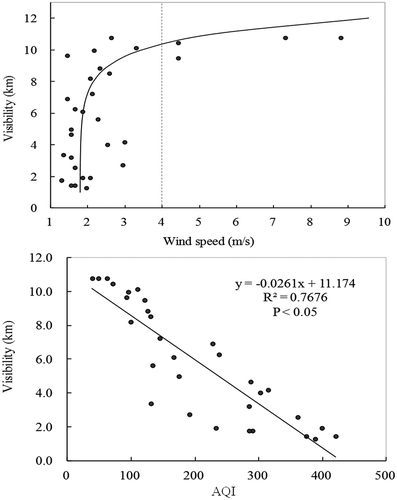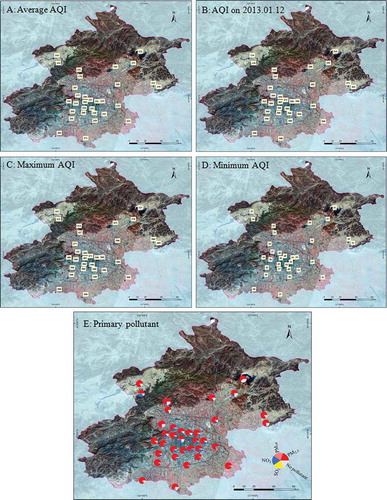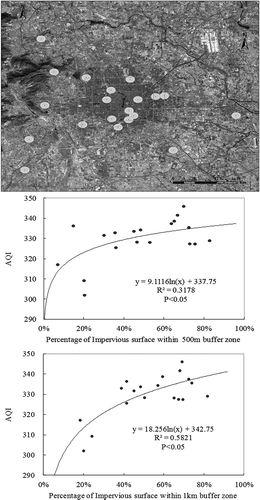Abstract
Air pollution gained special attention with the rapid development in Beijing. In January 2013, Beijing experienced extreme air pollution, which was not well examined. We thus examine the magnitude of air quality in the particular month by applying the air quality index (AQI), which is based on the newly upgraded Chinese environmental standard. Our finding revealed that (1) air quality has distinct spatial heterogeneity and relatively better air quality was observed in the northwest while worse quality happened in the southeast part of the city; (2) the wind speed is the main determinant of air quality in the city—when wind speed is greater than 4 m/sec, air quality can be significantly improved; and (3) urban impervious surface makes a contribution to the severity of air pollution—that is, with an increase in the fraction of impervious surface in a given area, air pollution is more severe. The results from our study demonstrated the severe pollution in Beijing and its meteorological and landscape factors. Also, the results of this work suggest that very strict air quality management should be conducted when wind speed less than 4 m/sec, especially at places with a large fraction of urban impervious surface.
Implications: Prevention of air pollution is rare among methods with controls on meteorological and urban landscape conditions. We present research that utilizes the latest air quality index (AQI) to compare air pollution with meteorological and landscape conditions. We found that wind is the major meteorological factor that determines the air quality. For a given wind speed greater than 4 m/sec, the air quality improved significantly. Urban impervious surface also contributes to the severe air pollution: that is, when the fraction of impervious surface increases, there is more severe air pollution. These results suggest that air quality management should be conducted when wind speed is less than 4 m/sec, especially at places with a larger fraction of urban impervious surface.
Introduction
Beijing has undergone rapid geographical expansion and economic growth, which improve the material life of the residents but also bring several “urban diseases” (Hao and Wang, Citation2005; He et al., Citation2002; Han et al., Citation2014). Air pollution is one of the most severe “urban diseases” that Beijing has to face. In the 1990s, air pollution was very severe due to coal combustion, vehicle exhaust, fugitive dust, and other sources (Chang et al., Citation2009). Soon after that, the city was selected to host the 2008 Olympic Games, and special attention was been paid to air quality improvement (Streets et al., Citation2007). Actions including control of the traffic use rate, reduction of fossil fuel (particularly coal) consumption, and relocation of heavy industry started to take effect before the games (e.g., Zhou et al., Citation2010). Soon after the games, the vehicle population increased dramatically, which may result in Beijing’s air quality having been significantly improved during that period.
In January 2013, Beijing experienced historical heavy air pollution. In this particular month, very few days were observed with blue sky. Therefore, local residents, government, and environmental organizations paid a lot of attention to the condition of the severe pollution in that month. Until now, the pattern of the pollution has still not well examined.
Generally, serious pollution in the urban region and its surrounding area is not directly caused by sudden increases in the emission of pollutants but results from unfavorable meteorological conditions (Latini et al., Citation2002). These meteorological conditions are closely related to a reduction of the atmosphere’s ability to disperse pollutants and to transport pollutants from other areas. Also, urban landscape is another factor that may influence on air quality, because major human activity is taking place on it. However, for the historical polluted month, all the information just mentioned is very limited. Therefore, we collected air quality index (AQI) records from the office and analyzed it to (1) understand the spatiotemporal pattern of the air pollution, (2) examine the air quality response to key meteorological factors, and (3) assess the impact of urban landscape on air pollution in Beijing during the January 2013.
Materials and Methodology
AQI record
The new version of the air quality index called AQI, which was upgraded to a new standard of air quality in China (GB3095-2012: Ministry of Environmental Protection of the People’s Republic of China Citation2012), has been available in Beijing since Janurary 1, 2013. The AQI is calculated as the maximum pollution subindex of pollutants by the following formula (National Bureau of Statistics of China, Citation2008):
where Ii is the air quality subindex for pollutant i, which could be SO2, NO2, PM10, PM2.5, O3, or CO, Ii,j and Ii,j+1 are the air quality subindex for pollutant i at levels of j and j+1, respectively, Ci is the concentration of pollutant i, and Ci,j and Ci,j+1 are the concentration of pollutant i at levels of j and j+1, respectively. Values of Ci can be found in .
Table 1. Standard of each pollutant for calculating individual air quality (Ii)
Daily primary pollutant levels of SO2, NO2, PM10, PM2.5, O3, and CO were also obtained from the Daily Air Quality Report of Beijing at Beijing Municipal Environmental Protection Bureau (http://www.bjepb.gov.cn/air2008/Air.aspx).
Meteorological record, satellite images, and urban land cover
Beijing daily temperature, wind speed and direction, and visibility during January 2013 were collected from the Global Summary of the Day product, which is freely available at the National Climate Data Center in the United States, and those factors was averaged from stations in Beijing area to represent Beijing’s meteorological condition during the month. The Moderate Resolution Imaging Spectroradiometer level 1B (MODIS L1B) images were collected to illustrate the air pollution in Beijing during January 2013. Land cover data were obtained from Advanced Land Observing Satellite (ALOS) images with object-based classification and visual-interpretation technologies (Zhou and Troy, Citation2008). The major land use and cover classes (water, vegetation, bare ground, and urban impervious surface, which was defined as the artificial structures covered by impenetrable materials) were obtained within the 6th Ring Road of Beijing.
Data analysis
Air quality was first examined against four kinds of environmental backgrounds, such as traffic, urban area, rural area, and environmental background; then the relationship between AQI and wind speed and visibility was analyzed. Finally, urban land cover was correlated with AQI to evaluate the urban land cover contribution on air pollution.
Results
Satellite image was selected on Jan 12, 2013 when Beijing was covered with dust-haze that dust, smoke and other dry particles that obscured clean atmosphere air (). Air pollution in Beijing has suppressed visibility, which is directly affecting the local residents, and it raised a lot of public concerns. Statistically, a negative correlation (, R2 = 0.7676, P < 0.05) was obtained between AQI and visibility, and the visibility was significantly correlated with wind speed. In general, visibility was relatively better when wind speed was greater than 4 m/sec, indicating wind speed was a major factor in easing air pollution in Beijing.
Figure 1. Air quality of Beijing in January 2013 with space views of nonpolluted (2013.01.03) and polluted (2013.01.12) days.
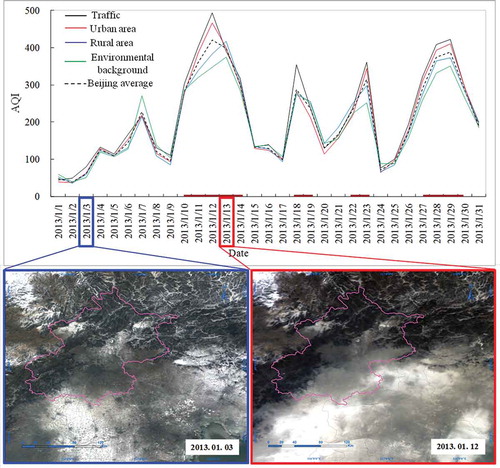
Five periods with heavy pollution (AQI > 200) were occurred during the 15 days of phenomena in the month, and 13 days of those observed had AQI > 300 (). Traffic and environmental background stations had the highest and lowest AQI during the heavy pollution days, respectively, indicating that the city’s traffic primarily contributes to the pollution when dispersion is very poor. Pollution in the urban area was also severe than that in the rural area, which implies that human activity also has a significant impact on the air quality.
Air quality was generally better in the northwest than that in the southeast (). Higher average AQI during January 2013 was found in the southeast monitoring stations, ranging between 200 and 300, and lower values were obtained in the northeast stations (100–200). A similar spatial pattern was found with maximum AQI during January 2013, with a maximum record of 500 in the southeast, and relatively low in the northeast, where it ranged from 100 to 300. The recorded AQI during the severe pollution day, January 12, 2013, when there were no precipitation and no strong wind but only a haze, illustrated a similar pattern of higher in the southeast and lower in the northeast. Nevertheless, the similar pattern was not found for the minimum AQI values during January 2013. Overall, the city center did not have significantly higher AQI as compared to the suburban areas. Fine particulate matter (PM2.5) is the primary pollutant during the month, and nitrogen dioxide (NO2) was found to be the second pollutant during the month (). PM2.5 influence was more in the southeast but less in the northeast of Beijing. NO2 in the 5th Ring Road was significant higher than in the suburban area, indicating the traffic is a major source of the air pollution in the city.
No clear wind direction was observed in Beijing (), because the wind speed was low during the month. However, the general wind speed in winter is from northwest to southeast, which may result in the spatial pattern of the AQI and pollutants distribution. Furthermore, frequency of wind direction with maximum and extreme wind speed was analyzed and there was found to be no similar pattern with AQI and pollutants distribution. No significant relationship was found between AQI and temperatures, including average, maximum, and minimum temperatures, indicating the heating emission is not a key factor in air pollution.
Figure 4. Frequency of wind direction with maximum and extreme wind speed at Beijing in January 2013.
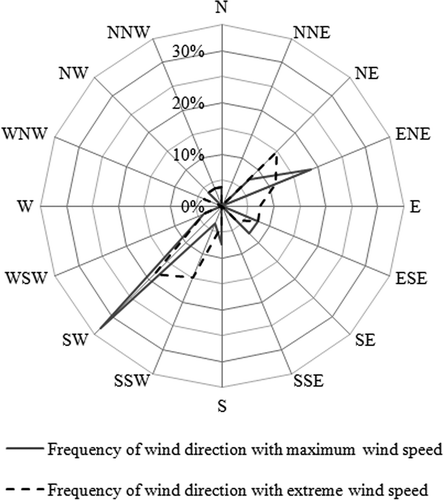
Impervious surface of urban landscape also has a relation with air pollution during the severe polluted days (AQI > 300), and that within the 6th Ring Road of Beijing was also analyzed. AQI was positively correlated with percentage of impervious surface with a 500-m buffer zone (, R2 = 0.3178, P < 0.05), and the relationship was enhanced when the buffer zone was expended to 1 km (, R2 = 0.5821, P < 0.05), indicating that pollutants emitted from urban impervious surfaces contributed to the severe pollution conditions.
Discussion and Conclusions
Meteorological condition is always an important factor that impacts the air pollution. A haze layer is frequently observed from an airplane over a city (Andreae et al., Citation2008), especially during calm days. During days with strong wind or rain, this layer disappears or at least is difficult to observe. Strong wind could immediately sweepe polluted air away from its origin to other areas; rainfall could wash the dirty air, even for only a short while. Our result showed that when wind speed is greater than 4 m/sec the air quality improved significantly in Beijing; this implies that meteorological factors, to some extent, could determine the urban air quality, suggesting when wind speed less than 4 m/sec, more strict actions than on days with stronger wind, to ease the pollutants emission, should be carried out.
Urbanization creates impervious surfaces that dominate the landscape. The urban impervious surface bears most of human activity (Carlson and Arthur, Citation2000); for instance, traffic emission occurs on the impervious road, and industrial emission happens on impervious industrial land. Therefore, the fraction of urban impervious surface to a certain extent could indicate the intensity of human activity. This was also demonstrated in our result that urban impervious increase makes air pollution severe when dispersion is very poor. However, due to the data limitation, we only used the portion of urban impervious surface in this analysis; further work to conduct more complex landscape factors with air pollution is suggested to better understand the impact of urban landscape on urban air pollution.
Moreover, NO2 was more severe in the downtown than in the suburban area, indicating emissions from the vehicles on the impervious road are highly attributed to the pollution in Beijing where about 5.2 million vehicles run on the surface, especially during days when dispersion is very poor.
We used the AQI, which is calculated based on the Chinese new environmental standard, to examine the air quality in Beijing during a severely polluted month, January 2013, for better understanding the spatial pattern of severe air pollution and its meteorological and urban landscape’s driving forces. Conclusions were as follows: (1) Air quality has distinct spatial heterogeneity that air quality is better in the northwest than in the southeast of Beijing during the severely polluted period. (2) Wind speed is the major meteorological factor that determines the air quality of the city. For a given wind speed greater than 4 m/sec, the heavy air pollution was removed significantly. (3) Urban impervious surface, as a medium where intensive human activity occurs, contributes to the severe air pollution period—that is, when the fraction of impervious surface increases, this results in more severe air pollution during the heavy pollution period.
The results of this work suggest the very strict air quality management should be conducted when wind speed is less than 4 m/sec, especially at places with more urban impervious surface. The results also suggest that air pollutants emission control should be a routine effort for Beijing, because the air pollutants mainly come from the human activity (e.g., vehicle emission) in the city. To adopt a better urban development way by considering both economic development and environmental harmony would be an ultimate objective for the city.
Acknowledgments
We thank the Beijing Municipal Environmental Protection Bureau for providing daily AQI and primary pollutant data of Beijing during January 2013.
Funding
This research was a part of Project Spatiotemporal Pattern of Urbanized Regions’ Particulate Matter (PMx) and Its Relationship with Landscape Pattern, supported by the Natural Science Foundation of China (NSFC41301199). In addition, the research received finical support from the Project Sponsored by the Scientific Research Foundation for the Returned Overseas Chinese Scholars, State Education Ministry.
Additional information
Funding
Notes on contributors
Lijian Han
Lijian Han, Weiqi Zhou, and Weifeng Li are assistant professor, professor, and associate professor, respectively, at Research Center for Eco-Environmental Sciences, Chinese Academy of Sciences.
Weifeng Li
Derege T. Meshesha is a post-doctor at Arid Land Research Center, Tottori University.
Derege T. Meshesha
Li Li is an assistant professor at Peking University Shenzhen Graduate School.
Li Li
Mingqing Zheng is working at Information Center, Ministry of Environmental Protection of P.R. China.
References
- Andreae, M., O. Schmid, H. Yang, D. Chand, J. Yu, L. Zheng, and Y. Zhang. 2008. Optical properties and chemical composition of the atmospheric aerosol in urban Guangzhou, China. Atmos. Environ. 42:6335–50. doi:10.1016/j.atmosenv.2008.01.030
- Carlson, T., and S. Arthur. 2000. The impact of land use—Land cover changes due to urbanization on surface microclimate and hydrology: A satellite perspective. Global Planet. Change 25:49–65. doi:10.1016/S0921-8181(00)00021-7
- Chang, D., Y. Song, and B. Liu. 2009. Visibility trends in six megacities in China 1973-2007. Atmos. Res. 94:161–67. doi:10.1016/j.atmosres.2009.05.006
- Han, L., W. Zhou, W. Li, and L. Li. 2014. Impact of urbanization level on urban air quality: A case of fine particles (PM2.5) in Chinese cities, Environ. Pollut. 194:163–70. doi:10.1016/j.envpol.2014.07.022
- Hao, J., and L. Wang. 2005. Improving urban air quality in China: Beijing case study. J. Air Waste Manage. Assoc. 55:1298–305. doi:10.1080/10473289.2005.10464726
- He, K., H. Huo, and Q. Zhang. 2002. Urban air pollution in China: Current status, characteristics, & progress. Annu. Rev. Energy Environ. 27:397–431. doi:10.1146/annurev.energy.27.122001.083421
- Latini, G., R. Grifoni, and G. Passerini. 2002. Influence of meteorological parameters on urban and suburban air pollution. Paper presented at the 10th International Conference on Modelling Monitoring and Management of Air Pollution, Segovia, Spain, July.
- Ministry of Environmental Protection of the People’s Republic of China. 2012. Ambient air quality standards (GB 3095-2012). Beijing, China: Ministry of Environmental Protection of the People’s Republic of China.
- National Bureau of Statistics of China. 2008. Technical requirements for urban ambient air quality daily report and forecast. Beijing, China: National Bureau of Statistics of China.
- Streets, D., J. Fu, C. Jang, J. Hao, K. He, X. Tang, Y. Zhang, Z. Wang, Z. Li, Q. Zhang, L. Wang, B. Wang, and C. Yu. 2007. Air quality during the 2008 Beijing Olympic Games. Atmos. Environ. 41:480–92. doi:10.1016/j.atmosenv.2006.08.046
- Zhou W., and A. Troy. 2008. An object-oriented approach for analyzing and characterizing urban landscape at the parcel level. Int. J. Remote Sensing 29:3119–35. doi:10.1080/01431160701469065
- Zhou, Y., Y. Wu, L. Yang, L. Fu, K. He, S. Wang, J. Hao, J. Chen, and C. Li. 2010. The impact of transportation control measures on emission reductions during the 2008 Olympic Games in Beijing, China. Atmos. Environ. 44: 285–93. doi:10.1016/j.atmosenv.2009.10.040

